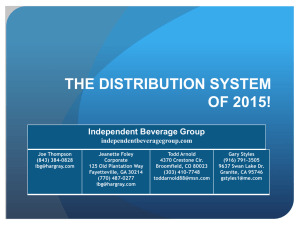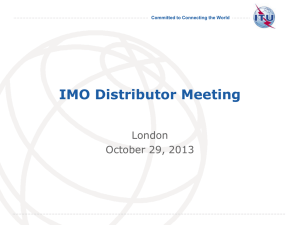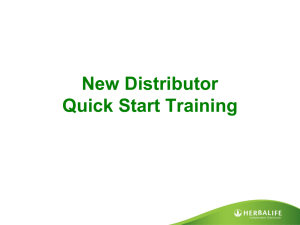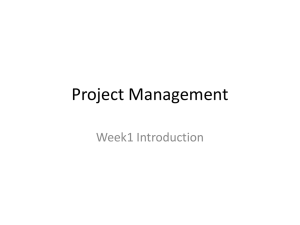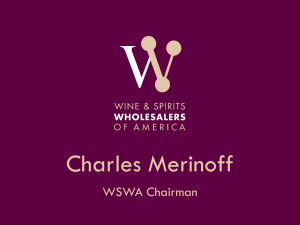Power Point - Independent Beverage Group
advertisement
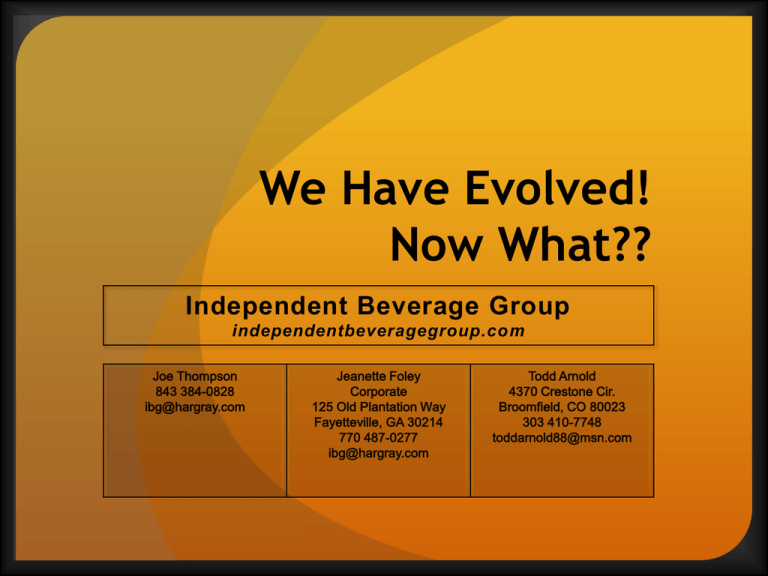
We Have Evolved! Now What?? Independent Beverage Group independentbeveragegroup.com 2 We Have Evolved! Now What?? I.Industry Overview II.Brewers III.Distributor Consolidation IV.Three-tier Distribution System - Mega Distributors V.Risk VI.Summary I. Industry Overview 4 I. Industry Overview Volume. Slow to no growth. Why?? Weather. Demographics. Economy. Aging Mega brands. Ineffective marketing. Consolidation. Bad management. Lack of innovation. Prices too high. Poor service to small accounts. Focused on cost cutting. Weak retail execution. 5 Per Capita Consumption Beer in Gallons Absolute Alcohol in Gallons Over 6 years, -6.9% decrease. +20.8% +30.0% -5.1% Consistently losing drinkers. 15 years of losing share of throat. . 6 I. Industry Overview Solid margin growth. Expanding above premium category. Aggressive price increases. Smarter price mix management Cost. Aggressive reduction at all levels. Profitability. Historic high. Conclusion: We are losing drinkers “but” profits are great. II. Brewers 8 “Big 4”struggling to revive aging brands. Macro (-8.8%), Micro (+8.0%) – Macros lost 8.8M bbls. in 5 years. At present rate of loss, macros will lose another 8.0M bbls. by 2016. 9 II. Brewers All brewers must continually reinvent themselves. Boston Beer (cider, tea). Crown (Expanding portfolio). Heineken (Femsa, S&N). Crafts (styles, packaging, names, labels, flavors.). ABI (Platinum, Lime-a-rita). MC (Tenth & Blake). All brewers aggressively pursuing above premium business. ABI and MC very successful. Developing brands. Acquiring craft brewers. Using scale advantage. Will accelerate craft consolidation. 10 II. Brewers 3 of top 4 Global ownership with worldwide options. 85% of US volume has the world, not just the US, as its target. Very focused and disciplined at reducing cost. Very sophisticated price management. PTR. FOB. Wall street. Must prove big brand building capabilities. Yuengling, Mikes, Pabst, Sierra, New Belgium, Boston, Brooklyn, Dogfish and other crafts are aggressive, innovative shining stars. Personalities, not monotone. Summary: Smart, stable, creative, adaptive, well-funded companies focused on growth and profitability. III. Distributor Consolidation 12 III. Distributor Consolidation Mega Distributor characteristics. Plus 15M cases. Multiple locations. Strong financially, often another source of wealth. Desire to grow. Good supplier relations. Management depth. Normally in population centers. Mid level distributor characteristics. 3M to 15M cases. Mid sized population centers. Other criteria same as mega distributors (just less). All others. Outside Mega / branch distributor footprint. Family owned and operated. Lower profit. People you want to drink a beer with. III. Distributor Consolidation Number of Distributors 13 14 III. Distributor Consolidation 2010: 950 distributors. 25 Mega distributors, 26% of industry volume. ABI. 11 Mega (counts 17 to 18 branches as 1). 338M ce’s (total house). MC. 14 Mega. 424M ce’s (total house). MC only volume (60% of total house). 325 Mid level distributors, 59% of industry volume. 600 other distributors, 15% of industry volume. 15 III. Distributor Consolidation 2020: IBG estimates 650 distributors. 30 Mega distributors, 41% of industry volume. ABI. 14 Mega (counting branches as 1). 297M ce’s to complete footprints. Branches in 2020 at 192M ce’s. MC. 16 Mega. 143M ce’s to complete footprints. 220 Mid level, 49% of industry volume. 400 other, 10% of volume. 16 • • 37.7% of Industry Volume(79M bbls.) legal to own brewery branches. ABI share 45.7%. Own/Control with no time restrictions. Limited partner Loan Only. No ownership or loan. ?? 17 WA ABI MT ME ND VT MN OR ID X WI SD X NE Klopsi MI c UT KS AZ Hensley Dobbs NM PA X OH IN IL CA RI CT ABI IA CO ABI ABI X ABI Stokes MO TN X WV Hand VA Jefferies NC OK AR SC TX Nau MS X AL Dormity GA LA FL Lamantia ABI Mega Distributors NJ ABI DE KY ABI Ben E. Keith MA ABI NY WY NV NH MD 18 WA CoHo MT ME ND Taylor VT MN OR NH MA ID Clay WY Ingram WI SD Reyes IA Clay HoBo MI NE NV NY CO X OH IL UT MC PA Monarch DE IN WV KS CA AZ MO X X Reyes VA KY NC Reyes Goldring / Moffat OK X Clay NM HoBo Andrews TN AR SC Glazer Reyes MS TX Keg 1 Glazer Andrew s MC Mega Distributors LA Goldring / Moffat AL X NJ GA X Taylor Reyes FL Gold Coast MD RI CT 19 III. Distributor Consolidation Pace is accelerating. ABI 20 transactions this year vs. 10 average. Current selling prices are highest ever. 10x to13x EBITDA for sellers – 7x to 10x for buyers. Any higher and other industries are more attractive. Low interest rates facilitating higher prices. Limited alternative investment opportunities cause some distributors not to sell. Availability / acceptance of outside money. Outside money currently views distributorships as safe. Banks will loan 5.9 to 6.5x combined cash flow. 20 III. Distributor Consolidation Future prices primarily affected by: Profits Interest rates Franchise laws Exclusive and Perpetual. Location and luck matter. Within Mega footprint or branch footprint may lower price. Need competition for higher price (creative solutions). Mega distributors will be the consolidation leaders moving forward. Financial capability. Use existing cash flow. Pressure on those within footprint. Know how to do deals. Synergistic value. IV. Three-tier Distribution System IV. Three-tier Distribution System 22 Current distribution model needs adjusting. •Many suppliers concerned with distributor performance. •Distributor personnel have less time to work per brand / SKU. • Technology can dramatically help selling time. Hours per week Minutes available Minutes to sell Number of Sku's Number of minutes per week per SKU to sell Number of seconds per week per SKU to sell Stops per week Stops per day # of seconds available to sell 2012 2007 1972 50 3,000 1,500 550 50 3,000 1,500 250 50 3,000 1,500 21 2.73 6.00 71.43 163.64 360.00 4,285.71 20 4 8 40 8 9 100 20 43 IV. Three-tier Distribution System Less competition has lead some to complacency. No fear of termination at distributor level. Slows elimination of under performers. Suppliers sales people hesitant to address poor performance. Suppliers more aggressive during consolidation. Resentment/anger more prevalent than ever at supplier level. Distributors need to develop value added services that influence consumers at the store level. Too often a replenishment system attitude. Losing local appeal / influence. Losing numbers advantage. 2,300 brewers, 950 distributors. Brand building margins are inconsistent with today’s cost cutting focus. Are suppliers getting what they pay for? 23 IV. Three-tier Distribution System Rapidly expanding portfolios. Enormous increase in SKU’s (MC network – 250 to 550 in last 5 years – Ed McBrien - 2012). MC system becoming beverage distributors. Columbia. ABI system mostly beer. Mostly ABI. New categories take more time and different skills. Energy drinks, pouches, cider. 24 IV. Three-tier Distribution System Lowering cost. Consolidation. Different service levels. Low volume accounts (tel-sell, call-in, twitter, fax, email, web-based orders). Improving technology. Vertique. Routing software. GPS tracking. Mega distributors centralizing functions (payroll, receivables, payables, routing, IT, fleet, HR, legal, insurance, benefits, real estate, purchasing, safety, forecasting, web platforms, etc.). Allows local management to focus on sales / service. Higher revenue. Better price mix management. Less discounting. Pushing back more on supplier’s suggestions. Becoming a bigger issue. Selling consumers on trading up. Summary: Distributors and suppliers need to get on same page. 25 IV. Three-tier Distribution System Mega Distributors Economics of mega distributor consolidation. Lower cost due to stronger management and horizontal shared services (14% - 16%). Gross profit is higher (26% - 28%). Profits rise rapidly with improved scale. 2005 AB Dallas convention - $.55. Currently range of $1.25 - $2.00 for Mega. 2011 MC Mega @ $1.58. $670M profit. 26 IV. Three-tier Distribution System Mega Distributors Mega distributors are different 3-tier model. Unique ownership. Unique skills – stronger financial capability. Probably more wealth in MC Mega system than ABI. Lower cost. Higher profitability per ce. Negative service reputation may be a myth. Very progressive mentality. Changed service levels to high and low volume accounts. Customizing service levels to retail almost by account. Different natural break on accounts (unique to each market.). Urban vs. rural. Small accounts have diverse make-up that requires various sales and service approaches. 27 IV. Three-tier Distribution System Mega Distributors Better use of technology. Willing to work with suppliers toward new balance between value added and profit. Some suppliers are afraid of change. Some are “intellectually lazy”. Mega distributors refer to some suppliers as some suppliers refer to distributors. Industry needs to customize service, sales and marketing by market. No more one size fits all. Every expectation should be localized. Start with Mega distributors. 28 IV. Three-tier Distribution System Mega Distributors More effective service to high volume / chains. Improved merchandising, GPS delivery / merchandiser tracking, scheduling, retail backroom inventory vs. sales rate, national accounts department, more local social interaction, more influence overall at retail. Scale is power. Segregate on-premise “Paradigm Accounts” for special activity. Expanded sampling and education with consumers. 100% elimination of OOS. Cost beer industry $15B per year in sales. FMI 2005 (Bump Williams). 29 IV. Three-tier Distribution System Mega Distributors Are Mega distributors good partners? Yes / maybe / no / depends. Tough negotiators with suppliers and fellow distributors. Push back attitude is change for suppliers. Levers of power are changing (except during transactions). “No divorce” laws cause complacency, arrogance and attitude. Professional management can be fired, distributor can’t be terminated. This new development could improve performance. What happens when financial times get tough? (Price wars, fuel cost escalates, volume loses, etc.). Aware that suppliers have fewer options (in some cases, no options). Sometimes abuse position. 30 IV. Three-tier Distribution System Mega Distributors Strained relationships? Overall distributor performance is different, not always wrong. Both need to adjust to new reality. Money is available. Skills are available. Is suppliers fear of losing control legitimate? What is too big? Capable of dramatic improvement in retail execution and consumer marketing. Profitability is causing a problem. Profit @ $1.00, no problem (Fat Cats). Profit @ $2.00, big problem (resentment, anger frustration, jealousy). Economics or emotion? Performance issue or “contempt prior to investigation”. Profitability makes money available to fix any problem. 31 IV. Three-tier Distribution System Mega Distributors Impact on Value. How does this affect value of non-mega distributors within footprints? Mega distributor/supplier branch may be only buyer. Skilled negotiators. Can wait for distributors circumstances to change. You probably bring contiguous value, but can you get any? What if outside footprint? No real need to worry or rush. Mini Mega distributors evolving. 32 IV. Three-tier Distribution System Mega Distributors Impacts on Value. Significantly affect day to day decisions of smaller distributors within footprint. Lose some independence / control. Sell in your territory. Get new brands for entire footprint / sub-distribute. Influence pricing / SKU’s you carry. Influence marketing (stadiums, arenas, $ per case). Can create negatives with suppliers / retailer. 33 IV. Three-tier Distribution System Mega Distributors Footprints should be over 90% complete by 2020. Industry leaders should use Mega distributors resources / skills to build a better 3-tier model. Reduced competition, no fear of repercussion, size and protective state laws have caused some to think they are invincible. Must continue to be efficiency oriented. 15% operating cost as a % of sales target. 34 V. Risk 36 V. Risk Dramatic changes to franchise laws as distributors lose local and legislative influence. Industry fails to resolve the margin vs. performance issue by developing a progressive 3-tier model based on today’s reality on a market by market basis. Tax Increases. Federal tax increase. Equivalency argument. State tax increases. WA state increase (1.10 per c/e Big 2, nothing craft). Wine and spirits taking beer drinkers. Availability, price, marketing. Industry confuses profit for performance as measure of success. VI. Summary 38 VI. Summary Profits are great but Industry losing drinkers. Successfully taking cost out of system with consolidation and technology. Mega distributors continue using horizontal shared services of non-sales functions to reduce costs. Too much conflict between distributors and suppliers. There are solutions but we are too resistant to change and intellectually lazy. Mega distributors will continue to grow. Will be driving force in consolidation for next few years. Mega distributors, working with suppliers, have the skills and resources necessary to build a high tech, efficient and effective distribution model for the 21st century. More negative risk than in the past but also resources to solve, and rewards if we do. Great time to buy distributorships, great time to sell.
